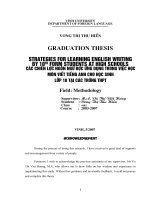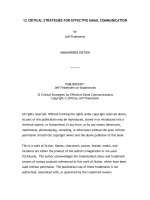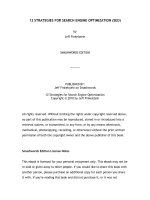12 CRITICAL STRATEGIES FOR EFFECTIVE EMAIL COMMUNICATION by Jeff Finkelstein pot
Bạn đang xem bản rút gọn của tài liệu. Xem và tải ngay bản đầy đủ của tài liệu tại đây (52.39 KB, 11 trang )
12 CRITICAL STRATEGIES FOR EFFECTIVE EMAIL COMMUNICATION
by
Jeff Finkelstein
SMASHWORDS EDITION
* * * * *
PUBLISHED BY:
Jeff Finkelstein on Smashwords
12 Critical Strategies for Effective Email Communications
Copyright © 2010 by Jeff Finkelstein
All rights reserved. Without limiting the rights under copyright reserved above,
no part of this publication may be reproduced, stored in or introduced into a
retrieval system, or transmitted, in any form, or by any means (electronic,
mechanical, photocopying, recording, or otherwise) without the prior written
permission of both the copyright owner and the above publisher of this book.
This is a work of fiction. Names, characters, places, brands, media, and
incidents are either the product of the author's imagination or are used
fictitiously. The author acknowledges the trademarked status and trademark
owners of various products referenced in this work of fiction, which have been
used without permission. The publication/use of these trademarks is not
authorized, associated with, or sponsored by the trademark owners.
Smashwords Edition License Notes
This ebook is licensed for your personal enjoyment only. This ebook may not be
re-sold or given away to other people. If you would like to share this book with
another person, please purchase an additional copy for each person you share
it with. If you're reading this book and did not purchase it, or it was not
purchased for your use only, then you should return to Smashwords.com and
purchase your own copy. Thank you for respecting the author's work.
* * * * *
Thanks to the whole Customer Paradigm team for helping me hone these
strategies into working principles.
* * * * *
12 CRITICAL STRATEGIES FOR EFFECTIVE EMAIL COMMUNICATION
* * * * *
INTRODUCTION
Most people do not send effective email messages. I know. I spend a lot of time
analyzing email messages for our clients, and measuring and tracking their
effectiveness.
Whether you send large email newsletters or just use email to
communicate with friends, colleagues and customers, following these twelve
strategies will make your email more effective.
So, here’s my list, compiled and crafted from years of experience and
quantitative analysis of tens of millions of messages we’ve sent out for our
clients:
RULE # 1: ONE MAIN MESSAGE PER EMAIL
The most effective email messages have one main idea or concept. I spent
a summer as an intern at the White House, helping to read and answer the
mail. The writing staff taught that the strongest messages were ones that
didn’t distract people with extraneous information.
I’m sure you’ve received a message from someone that has eleven
different ideas and thoughts that ramble from paragraph to paragraph.
So if you’re like most people (myself included), you’ll just leave this
complicated message for later, and focus on another email or task that’s much
easier to accomplish.
Before you start writing a message, write down what you’re trying to
communicate. Or at least think about your message before you start writing.
The most effective messages are ones that are crisp, clear and concise.
* * * * *
RULE # 2: KEEP IT SHORT
If you’re like me, the phone rings off the hook, people walk over to your
desk to ask you a question, and other people are instant messaging you. And
then your cell phone starts ringing. It’s enough to make anyone a bit crazy and
give you Attention Deficit Disorder.
Our collective attention spans are very short. People simply have too many
distractions to wade through a really long email. You might think they need all
of the information.
But when people are faced with dense blocks of text, many people’s eyes
glaze over. And then they ignore the entire message.
And thus, the most effective email messages are short. Two or three short
sentences in length. Perhaps a couple of bullet points. And perhaps the short
message is followed by supporting material, an attachment or a link to more
information on a website.
Enough said. I’ll try to keep this section short.
* * * * *
RULE # 3: KEEP IT RELEVANT
I believe that attention is the most important asset of any business or
organization. What do I mean by this? If your messages are relevant, your
recipients will pay attention to what you are trying to say.
If your messaging is not relevant, however, you’re quickly going to find
that your messages are filed in the "I’ll get to these later" pile.
If you send email that isn’t relevant — they will quickly stop paying
attention to your messages.
It’s easy to get into a mentality where you want to send everything to
everyone. And with email newsletters or mass broadcasts, it’s not that
expensive to do. However, once someone feels your messages aren’t that
important, they will simply stop reading them.
* * * * *
RULE # 4: REPLY EARLY & REPLY OFTEN
With the huge volume of spam, it’s tough to know if your message got
through. Right now, four out of every five emails sent over the Internet today
is spam. With so much junk, it’s easy for your message to get lost, trapped in a
junk mail filter, or simply piled up in someone’s ever-expanding inbox.
So you start to worry when you haven’t heard back from someone that you
emailed a couple of days ago. Hmmmm, you say. Did that person get my
message? Should I send it again? If I do, will that bug them? Am I being too
pushy?
So when you’re on the other side of the email message, it’s really
important to reply early and reply often.
What you’re doing is letting them know you (a) received the message and
(b) that you care. Even if you’re not able to take action on their message right
away, replying back with a quick message indicates that you’re not ignoring
them.
Replying early to a message could be as basic as something like this:
Bob-
Thanks for sending this over. I'll work on this later today.
Thanks,
Jeff
We’ve found that replying early and often dissipates a lot of anxiety and
tension, and allows the person who sent you a message to know that they don’t
have to worry about it.
* * * * *
RULE # 5: FROM LINE
The single most important part of an email message is the From line. If the
person you’re sending to doesn’t recognize your name, your message will be at
best skipped over. At worst, it will be simply deleted without opening.
Most email programs show a friendly display name instead of the plain
email address.
The From line of your email (friendly display name) should have your full
name and organization in it.
For example, when I send out an email, my from line reads: Jeff
Finkelstein – Customer Paradigm. When someone receives an email from me,
it’s pretty clear which person named Jeff the message came from. And if they
don’t know me, but know my company instead, they won’t completely ignore
my message.
But at least a couple of times per week I get an email that was meant for
someone else named Jeff, but works at a different company.
The culprit is that many people have only their first names listed in the
friendly From display line. Most of the time the messages aren’t too racy, but
with email programs that automatically fill in an email address when you start
to type a first name, it’s easy to email the wrong person something that could
be seriously career limiting.
* * * * *
RULE # 6: SUBJECT LINE
After the From line, the subject line is the second most important part of
an effective email. If you forget to include a subject line, your message is
much more likely to go into a junk mail folder, or just not be opened.
Email marketing professionals live and die by subject lines. A good subject
line will sum up what the message is all about, but still entice someone to open
the message, read it, and take action.
Personalizing a subject line with your company’s name or the recipient’s
name or other information can also lead to higher message open rates.
Including the company name in the subject line can increase open rates by
up to 32 percent to 60 percent over a subject line without branding. (Jupiter
Research)
* * * * *
RULE # 7: PERSONALIZE EACH MESSAGE
Except when being called into the principal’s office, everyone likes being
called by their name. In this impersonal world of email messages, people like
to know that you know who they are, and that you care about them as a
person.
Nothing is worse than a highly demanding email that is sent without being
addressed to someone by name and is out of context. A message that starts:
"Can you make these changes ASAP?" puts you on the defensive right way. You
might think: Why should I care if they are in a hurry?
It’s so much nicer to have a message that begins with: "Jeff – I hope you’re
doing well. I just found out that we’re going to be mentioned on the front page
of The Wall Street Journal tomorrow. Can you make these changes ASAP?"
Wow. I’m much more willing to help someone who personalizes the
message to me, and gives me a non-threatening reason why this needs to really
be done by tomorrow.
* * * * *
RULE # 8: ALWAYS INCLUDE YOUR CONTACT INFORMATION
I can’t tell you how many times I’ve not returned a call promptly because I
didn’t have someone’s contact information readily available.
I’m sure you’ve had the same experience. Someone emails you to please
call them. But they didn’t give you a phone number, and there isn’t one listed
in their signature line. You then have to dig through past emails, look in your
address book, Google them, and still you aren’t able to find their direct line.
In this age of iPhones, Blackberries and cellphones, it’s rare that I have a
phone number memorized.
I know this is a simple and basic thing. But so many people don’t follow it.
If you want someone to respond to you, you’ve got to make it as easy as
possible for them. Same thing goes for leaving a voice mail.
So many people rush through their phone number, making it virtually
impossible to write down the number without having to go back and listen to
their message a couple of extra times. Ideally, you should always give your
phone number, say it slowly, and repeat it twice so that someone can write it
down and then make sure it’s correct.
Effective emails always include a signature line with contact information.
You should include your contact information in every new message or every
message you reply to.
* * * * *
RULE # 9: STRONG CALL TO ACTION
In direct marketing or email correspondence, most of the time you want
someone to take a specific action when they receive your message. You might
want to set up an in-person meeting, or have them click through to a website
to read more. Or respond back and say, "Yes, let’s go ahead with the project."
The most effective email messages always have a strong call to action,
telling the recipient what you want them to do.
I’m sure you’ve received long, rambling emails from people. And by the
time you get to the end, you don’t really know what you’re supposed to do (if
anything). Is this a message that is just nice to read and have for future
reference? Or do they want me to actually do something?
Email is a low context medium. It doesn’t transmit behavioral clues like
voice inflection that might otherwise indicate what you want a person to do. So
it’s important to be direct and ask what you want the other person to do. It
sounds basic, but it’s a key to effective email.
* * * * *
RULE # 10: PASTE LINKS & GET ON THE SAME PAGE
How many times have you felt that the person receiving your email just
isn’t on the same page as you? A lot of times it’s literally true. You might be
thinking that they are looking at one page on a website, when in fact they are
looking at something completely different. I know I’ve been frustrated by this
in the past.
Simple pasting a link into an email is the best strategy. Again, it seems
simple, but it can mean the difference between confusion and clarity.
It’s also easy to do, and takes very little time. In your browser, simply
copy the website address (i.e. www.CustomerParadigm.com) and paste it into
the body of the email message. On a PC, the Control-C shortcut will copy; the
Control-V will paste.
Sending someone the exact link to the website page you are discussing
gets everyone on the same page.
* * * * *
RULE # 11: USE FOLDERS & FILTERS
If you’re like me and you receive a lot of email, you can use folders to
store messages from different people or clients.
In most email programs, you can set up automatic rules (often called
filters) that will place all messages from Joe into a specific folder.
That way you can review all of the messages Joe sends over to you, reply
to the ones that need attention, and not have to spend the time moving the
messages from the inbox to another folder when you’re finished. All of the
messages addressed to , for example, go to a
different folder that I don’t check as often, because people who send to that
address are usually trying to sell me something.
This one strategy has made me amazingly more efficient at dealing with
the large volume of email I receive each day (usually about 950 messages per
day).
* * * * *
RULE # 12: KNOW WHEN EMAIL DOESN’T WORK
Pick up the phone instead
Email remains one of the primary ways that businesses communicate
internally among their staff, and externally with their customers, suppliers and
other stakeholders.
However, make sure you recognize when email is losing its effectiveness.
It’s easy to hide behind email when we don’t want to speak to a scary client or
team member. I’ve been guilty of that as well when I have a million things
going on. But sometimes a three minute conversation can clear up the
confusion inherent in five days of back-and-forth email messages.
* * * * *
ABOUT THE AUTHOR
Jeff Finkelstein is the founder of Boulder-based, Customer Paradigm, an
interactive marketing firm that has helped clients achieve top rankings through
search engine optimization and web marketing. Finkelstein is an adjunct
professor for Colorado State University, and has lead workshops around the
country teaching companies how to better optimize their websites and get
found. Finkelstein has written syndicated columns on web marketing, and
reaches tens of thousands of people each week through Customer Paradigm's
eLearning Series newsletter.
Finkelstein also helps his wife, Rabbi Jamie Korngold, run the Adventure
Rabbi program. Through search engine optimization, reporters from Good
Morning America, The Wall Street Journal, USA Today, CBS News and Ski
Magazine found out about the organization and ran articles and TV segments.
This intense media interest sparked a book offer from Doubleday Religion, who
published Rabbi Korngold's best-selling book, God in the Wilderness, in April
2008.
Finkelstein has been featured in The New York Times as a Web Guru, and
his company has received numerous awards, including the prestigious 2008
Rocky Mountain Direct Marketing Association Supplier of the Year Award.
Finkelstein lives in Boulder, Colorado with his wife and two daughters.









